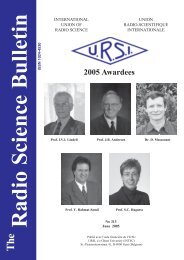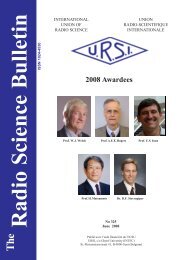December 2012 - URSI
December 2012 - URSI
December 2012 - URSI
Create successful ePaper yourself
Turn your PDF publications into a flip-book with our unique Google optimized e-Paper software.
Figure 1a. The closed contour of integration as implemented<br />
by Sommerfeld in the lower complex plane.<br />
Figure 1b. The actual location of the pole in the<br />
lower complex plane.<br />
of these are the necessary conditions for the convergence of<br />
the integral at infinity fulfilled. According to Sommerfeld,<br />
the path of integration can be resolved on this sheet into<br />
three parts. The first part is a loop from infinity about the<br />
branch point k 1the second part is a similar loop about<br />
k 2 , and the third part can be any small circle about<br />
the pole P<br />
, as seen in Figure 1a. The contributions of<br />
the loops about the branch points give the dominant terms<br />
jk1R<br />
jk<br />
at e<br />
2R<br />
and e , which can be identified as the space<br />
waves. R The residue R at the pole has a variation of the form<br />
jPR<br />
e , which had all the hallmarks of a true surface wave,<br />
but Rnot a Zenneck wave. (We will discuss the properties of a<br />
surface wave in the next section. However, suffice it to say<br />
that it is a slow wave for a lossless dielectric medium and<br />
there is practically no loss in the direction of propagation.<br />
The fields in the transverse directions are evanescent, and<br />
as the frequency increases, the wave is confined close to<br />
the surface. However, it is not a Zenneck wave, as it is a<br />
slow wave.) Here, R is the distance between the source and<br />
the observation (field) point. The mathematical subtleties<br />
that differentiate a surface wave from a Zenneck wave are<br />
explained in the next section.<br />
Sommerfeld thus obtained results that lent considerable<br />
credence to Marconi’s view that the electromagnetic wave<br />
was guided along the surface. As Collin noted in [3], as<br />
early as 1902, Kennelly [19] and Heaviside [20] predicted<br />
the existence of an ionized layer at a considerable height<br />
above the surface of the Earth. It was thought that such<br />
a layer could possibly reflect the electromagnetic waves<br />
back to the Earth. This was experimentally verified by<br />
Brett and Tuve in 1926 [21]. No serious challenge to the<br />
surface-wave mechanism for long-distance propagation<br />
thus occurred until a decade later, when Weyl published a<br />
paper on the same subject. Weyl obtained a solution very<br />
similar to that found by Sommerfeld [17], but without the<br />
surface-wave term [23]. Weyl [23] obtained an asymptotic<br />
series representing the diffracted field by applying a method<br />
of steepest descent. Weyl’s solution also reduces to a form<br />
that can be interpreted as the superposition of a space and<br />
Figure 1c. The contribution of the pole generating<br />
the surface wave is excluded when the branch-cut<br />
contour is chosen vertically (Kahan and Eckart<br />
[22], Baños [6, pp. 55]).<br />
a surface wave, but the Weyl surface wave is not identical<br />
to that of Sommerfeld [17] and Zenneck [15].<br />
In 1926, Sommerfeld returned to the same problem.<br />
That time, he solved it [22] using a different approach, and<br />
confirmed the correctness of Weyl’s solution [23]. With a<br />
better understanding of the ionospheric mode of propagation,<br />
the concept of the surface wave being the important factor<br />
for long-distance propagation lost favor. It is the presence<br />
of the Kennelly-Heaviside layer of the ionosphere that<br />
is responsible for the long-distance propagation of the<br />
long-wavelength fields. In 1930, Van der Pol and Niessen<br />
published a new solution to the old Sommerfeld problem,<br />
using yet another method of solution [24]. Again, the<br />
results of Weyl and the later results of Sommerfeld were<br />
confirmed. This was followed by another paper of Van der<br />
Pol on the same problem [25]. Each independent solution<br />
of the old Sommerfeld problem agreed with Sommerfeld’s<br />
1909 solution, except for the surface-wave term.<br />
In the 1930s, Norton undertook the task of reducing<br />
the formulas of Van der Pol and Niessen to practical form<br />
for the radio engineer [26-28]. As a part of this undertaking,<br />
8 The Radio Science Bulletin No 343 (<strong>December</strong> <strong>2012</strong>)
















